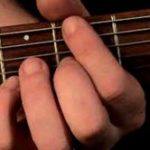Open Chords
Guitar Chords: An Introduction
In this lesson, you’ll learn a little about guitar chords and what you can expect in subsequent lessons. I’ll give you three rules to help you succeed at playing chords and a timetable for completing the course.
How To Read A Chord Diagram
Chord diagrams show us, in graphical form, how to play new chords. This lesson will teach you how to read these chord diagrams.
The Five Basic Chord Shapes
Here are the very first chords you should learn. They are the five basic chord shapes found on the guitar. Most of the chords you’ll learn in the future are based on these five basic shapes.
The E Chord Group
In this lesson we’ll learn our first chord group. You’ll learn how to play 4 chords: E, Em, E7, and Em7. It may take you several minutes to form the chords. Practice them a little every day until forming the chords becomes second nature. Take a break for the day if your fingertips get tender from fretting the chord. Rome wasn’t built in a day…
C Chord Group
Here’s the C chord group. The C chord very well may be the most used chord on the guitar. In this lesson you’ll learn how to play C, CM7, and C7. The CM7 (C major 7th) acts as a great substitute for a C chord. It’s easy to play, too. Whereas the C7 chord is the hardest chord to form that we’ve learned so far.
D Chord Group
In this lesson, we’ll learn 5 chords in the D chord group. You’ll discover the D, Dm, D7, DM7, and Dm7 chords. These chords are very similar in name and shape, so spend extra time each day practicing them until you can easily recall them by name.
G Chord Group
In this lesson, we’ll learn 3 new chords: G, G7, and GM7. Some beginners find the G chord hard to form, so if you find it difficult, realize you’re not the only one.
A Chord Group
Congratulations! You’ve made it to our last chord group. We still have more chords to learn later in the course, but we’re going to take a break from that. Once you are done with this lesson we’ll begin working on changing and strumming the chord we’ve learned.
Common Open Chords Recap
We’ll review the chords we’ve learned so far and discover a handy chord chart.
What’s Next?
Now you can play the common open chords. What comes next? The next step on your journey is to learn how to play barre chords!
Beyond Open Chords
Open chords are great, but all chords can’t be played in the open position. You’ll notice that there are chords that seem to be missing such as F chords and B chords as well as chords with sharps or flats. Well, these chords don’t have their own shapes on the fretboard. To play them (and all the other major and minor chords for that matter) you have to use a barre chord. Barre chords are movable chord shapes.
Major Chords Barred
E Shape Barre Chord Exercises
A Shape Barre Chord Exercises
In these exercises, you are to figure out the barre chord that needs to be played, and apply them to strumming basic quarter notes. For the first few pages of exercises I’ve include red lettering that indicates the fret at which the barre chord is played.
Play Some Songs
Visit the Chords 101 Strumming Library
